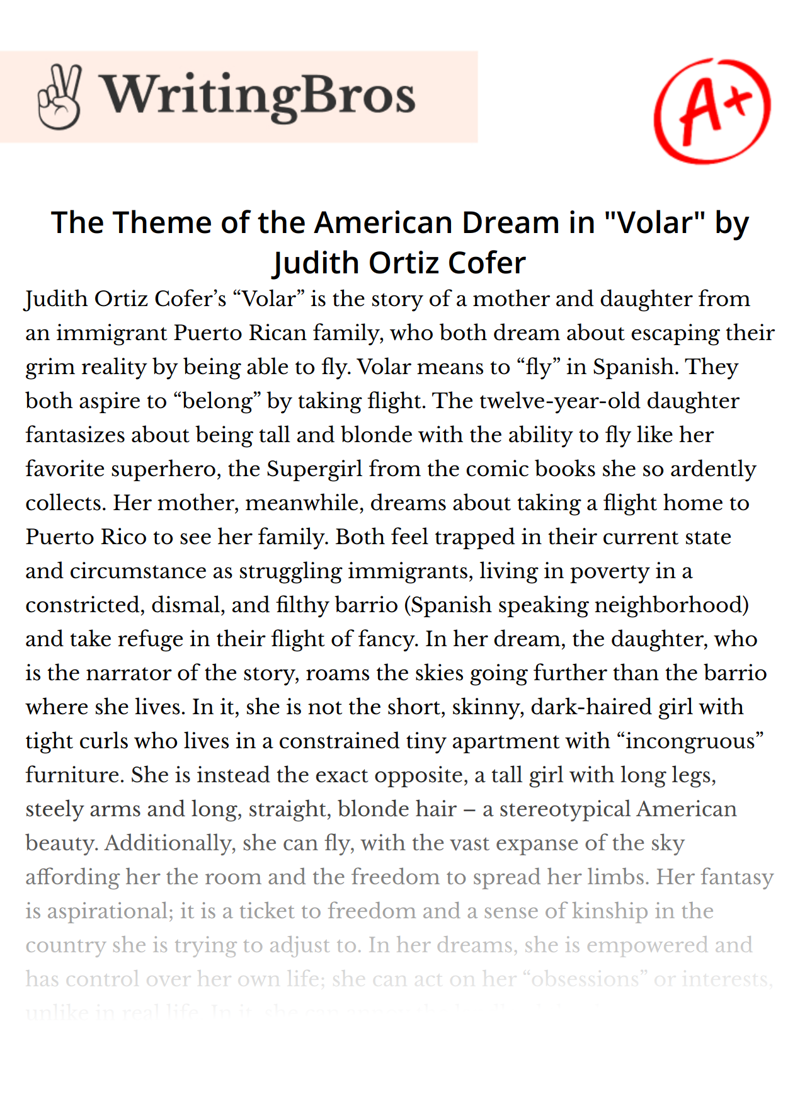The Theme of the American Dream in "Volar" by Judith Ortiz Cofer

Judith Ortiz Cofer’s “Volar” is the story of a mother and daughter from an immigrant Puerto Rican family, who both dream about escaping their grim reality by being able to fly. Volar means to “fly” in Spanish.
They both aspire to “belong” by taking flight. The twelve-year-old daughter fantasizes about being tall and blonde with the ability to fly like her favorite superhero, the Supergirl from the comic books she so ardently collects. Her mother, meanwhile, dreams about taking a flight home to Puerto Rico to see her family. Both feel trapped in their current state and circumstance as struggling immigrants, living in poverty in a constricted, dismal, and filthy barrio (Spanish speaking neighborhood) and take refuge in their flight of fancy.
In her dream, the daughter, who is the narrator of the story, roams the skies going further than the barrio where she lives. In it, she is not the short, skinny, dark-haired girl with tight curls who lives in a constrained tiny apartment with “incongruous” furniture. She is instead the exact opposite, a tall girl with long legs, steely arms and long, straight, blonde hair – a stereotypical American beauty. Additionally, she can fly, with the vast expanse of the sky affording her the room and the freedom to spread her limbs.
Her fantasy is aspirational; it is a ticket to freedom and a sense of kinship in the country she is trying to adjust to. In her dreams, she is empowered and has control over her own life; she can act on her “obsessions” or interests, unlike in real life. In it, she can annoy the landlord that her parents so fear, look in on her neighbors, teachers, and the boys she likes. She longs to transcend her current existence and fancies freedom in the incarnation of someone who looks more like a “local” and who is confident like one. She wants to assimilate in and identify with the country she lives in. She takes to fantasizing about that which seems unattainable.
The mother’s story unfolds at dawn. The parents of the little girl like to spend a little time on their own before she wakes up; it is their time to themselves before their responsibilities come knocking in the form of their daughter. The daughter gives then that space by staying in her tiny, limited space liberated only by her fantasy of flight. Her mother wishes that she could return to her family in Puerto Rico, clearly a place that is the exact opposite of where she lives with its open beaches and kin. That’s where she is the happiest. The father tries to interest her with local news about the barrio and her life in the US, but she has her sights set clearly on flying to Puerto Rico. As her father gently reminds her of their financial stress, which makes flying back home unaffordable, she sighs deeply and says, “Ay, si yo pudiera volar” (“Oh, if only I could fly”), putting in words her daughter’s fantasy. It is interesting to note that the narrator’s father, a hardworking immigrant who has to toil every day to provide for their meager existence, “It is not possible for me to take the time off…please understand,” is firmly rooted in the reality of their situation.
He is engaged in realizing the storied if somewhat cliched “American dream” through “hard work.” The narrator’s mother bides her time while immersed in her dreams, as symbolized by the clock over her kitchen sink, which has a prayer for patience and grace, written in Spanish. The fact that it was a birthday gift seems to indicate that the passage of time, and even milestones that mark each year, need to endure with fortitude as there appears to be no respite from her confined existence. The mother identifies with preserving her identity by being amid her family in her home in Puerto Rico.
“Volar” uses the symbolism of flight to describe the daughter and mother’s yearning to escape their status as outsiders with a distinct ethnic heritage living in America. The daughter wants to “belong” by assimilating her identity into an “American” one. The mother, on the other hand, sees the reality of their hardship with no reprieve in sight, so she finds happiness in her own identity and culture. The “American dream” is elusive to her, so going back to her homeland to “belong,” is her relief. Their wistful dream of flying is as unrealistic as their hope to unshackle themselves from their dreary existence as ethnically isolated immigrant outsiders in America.
References
- Cox, T. (2017). Assimilation and integration. Oxford Research Encyclopedia of Communication. https://doi.org/10.1093/acrefore/9780190228613.013.428
- Gibson, M. A. (1998). Immigration and the experience of self: A symbolic interactionist perspective. International Migration Review, 32(3), 673–693. https://doi.org/10.1177/019791839803200305
- Huntington, S. P. (2004). Who are we? America’s great debate. Simon & Schuster.
- Kymlicka, W. (1995). Multicultural citizenship: A liberal theory of minority rights. Oxford University Press.
- Lopez, D. (2006). The meaning of “American”. Harvard University Press.
Cite this Essay
To export a reference to this article please select a referencing style below

